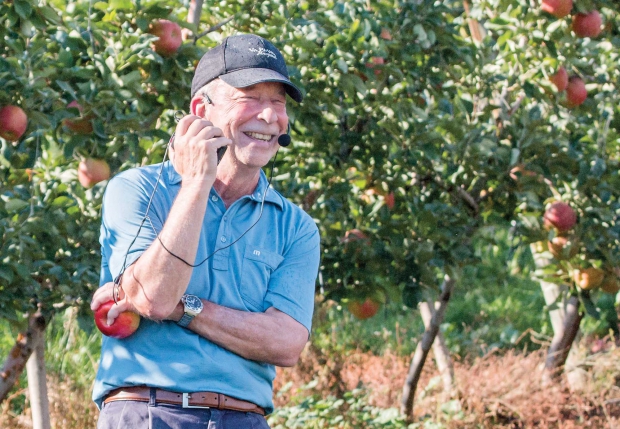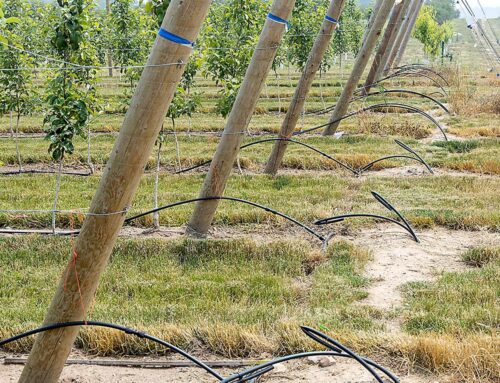
Bruce Allen shared the challenges of growing Honeycrisp apples during a field day held at his Chiawana Orchards in Gleed, Washington. He cautioned growers from planting more Honeycrisp unless they have the right location, can plant new strains, and can grow the right size. (TJ Mullinax/Good Fruit Grower)
Bruce Allen has been growing Honeycrisp apples in Washington State for almost 14 years and is still learning how to best grow it.
Each Honeycrisp orchard seems to vary, he says, and it’s a struggle to hit 15 packs per bin of Honeycrisp. Although Allen tries to sort fruit at harvest into different quality categories to help with postharvest storage management, doing so is very difficult because of the size and quality differences within each block.
“We grow way too many big Honeycrisp,” Allen told industry members attending a Honeycrisp seminar sponsored by Washington State University. The session was in conjunction with the Washington State Horticultural Association’s annual meeting.
Allen has been an apple grower in Yakima, Washington, since 1974 and is owner of Columbia Reach, a tree fruit packer-shipper also located in Yakima.
During a grower panel discussion, he said it’s easy to get 19 packs per bin with Gala apples, a number that gives a gross return of around $400 per bin.
In comparing Honeycrisp profitability to Gala, Allen gave the following scenario:
Honeycrisp, at 11 to 12 packs per bin that sell for $40 per pack (box), will return a gross of $440 to $480 per bin, before packing charges. But after packing charges, the grower return can shrink to around $280 per bin. “If you can hit 15 packs per bin, the picture is much prettier,” he said.
Gala, when selling at around $20 per box, will return about $180 after packing charges at 19 packs per bin. But if Gala sells for $25 per box, Allen said the potential return of around $275 per bin after packing charges is close to Honeycrisp returns—but without the horticultural and storage headaches that come with Honeycrisp.
Some Honeycrisp growers in Brewster average 16 packs per bin from regular storage and around 18 packs per bin from controlled atmosphere storage, said Jim Divis, general manager of Honeybear Growers in Brewster, Washington.
“I wish I could average those numbers,” Allen replied.
Mike Robinson, general manager for Double Diamond Fruit in Quincy, Washington, is also scratching his head after last year’s Honeycrisp crop. He shared the example of two growers—both of which he considers “good” growers—who had surprisingly different yields even though their orchards are within a half mile and share the same soil type.
One had 70 bins per acre of Honeycrisp that only had light yellow color and the other 90 bins per acre, but with much redder-colored fruit. He has yet to figure out what was different between the two sites. “Was it Karma?” he asked. “I thought I knew about Honeycrisp and then this happened.”
Robinson noted that Honeycrisp blocks that should have had color in 2014 didn’t and those that don’t usually have soft scald and bitter pit did. “I guess bad things happen to good people,” he said.
Location
Honeycrisp, selected by David Bedford of the University of Minnesota, is naturally suited for cold climates like those of Minnesota. Though growers in warm climates, such as Washington’s Columbia Basin, initially stayed away from the variety, high returns that have been more than double other varieties have encouraged growers throughout the United States to plant it and adopt practices to improve color and quality.
Allen believes that New Zealand has ideal locations for the variety. But for Washington, he thinks Kittitas County is a good location and has recently planted several Honeycrisp orchards there, which he describes as having a very cool microclimate.
“The color difference is night and day between there and even a Naches Heights (Yakima County) location,” he said. “We grow lots of Honeycrisp on Royal Slope, but they don’t look nearly as pretty.”
In addition to choosing the right site, using quality plant material and budwood is important, Allen said. It’s not an issue of top-working (grafting) vs. planting new trees. “The real issue is the quality of budwood and plant material. You need to get the very best that’s out there.”
Reflective ground covers
All three panelists have tried reflective ground covers for Honeycrisp, but with varying results. Though Allen dislikes the high cost of the Extenday ground cover, in his own trials he’s found a higher percentage of premium fruit in the first two picks when using the ground cover than without. In orchards located in the Columbia Basin, using reflective material results in fruit with better color and internal quality. Allen would like to use mylar reflective material because it’s cheaper, but he says it doesn’t hold up in comparison to Extenday when using lots of water for overhead cooling.
Robinson has conducted trials with and without mylar ground covers in previous years and has yet to see a difference when fruit runs over the packing line.
“I did more trials this year. Maybe I’m not looking at the right things,” he commented after Allen shared his results.
Divis added that he, too, did trials years ago with mylar and didn’t see any differences at the packing house. “But I put it down in all of my Honeycrisp blocks because it makes me feel like I’m doing everything I can.”
New strains
New Honeycrisp strains with more red color are now available, and one is said to be three weeks earlier than standard Honeycrisp. Robinson believes new strains are near the range of existing Honeycrisp color and not likely to improve color for Honeycrisp already grown in a good site. But the strains may help orchards achieve redder and more consistent color in warm sites.
Allen advised growers to assess all the new strains side by side to see which is best for their particular location and harvest timing.
Divis shared that he has ten test trees of the early strain called Premier, discovered in Pennsylvania, and is planting a five-acre trial this spring. He added that an early Honeycrisp could have potential as a harvest management tool.
Killing the goose
Allen said that as a packer, he sees too much poor quality fruit. “We are killing the golden goose with green fruit. Too many of my growers bring in green fruit or fruit that’s overmature with off flavors. We’ve got to maintain the unique attributes of Honeycrisp, which is its flavor profile. If we don’t do that, we kill the golden goose.”
Growers and packers must learn to walk away from under- and over-cropped trees that have fruit with no flavor, he said, adding that off-flavors can develop within five days of picking. “You have to be able to eat what you grow. You need to ask yourself, would you eat this fruit out of the bin?”
He cautioned growers in planting more Honeycrisp. “If you have a really good site for Honeycrisp, can plant new strains, and can grow the proper size, then Honeycrisp is your best bet over the next ten years,” Allen said. “But if you can’t do those things, you should consider something else, such as Gala.” •






Leave A Comment